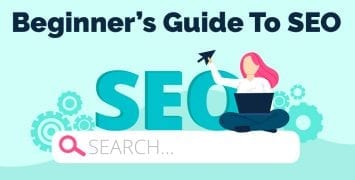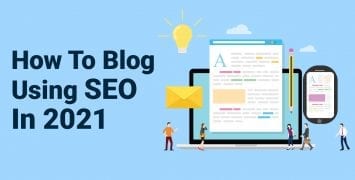Everyone wants a great blog, but most beginners don’t know where to start. If you have a blog already up and running, these 32 tips may help you improve even more.
I wanted to draw from my own personal experiences about blogging. Some of these techniques were hard-learned processes, and some I’m even still working on, having them in mindset for Webitect’s future. Hopefully, my experiences can help you too.
1. Having No Logo
 Branding is important in the blogging world, just as it would be for any other business. Get some sense of identity with a logo early on, and start marketing your blog as a business, rather than just another small blog on the Internet.
Branding is important in the blogging world, just as it would be for any other business. Get some sense of identity with a logo early on, and start marketing your blog as a business, rather than just another small blog on the Internet.
2. No Elevator Pitch
This one of the most important things I’ve learned so far on Problogger’s “31 Days to a Better Blog”. Creating an elevator pitch for your blog can help you advance it in a number of ways. In the words of Darren himself:
“Many business and self-improvement type courses teach students to develop an elevator pitch for their business (and even for themselves). The idea is to have something short and sharp that you can say about yourself when the opportunity arises instead of bumbling your way through explaining what you or your business does (and miss an opportunity).” – Darren, Problogger.net
Find out how to create your own, and what all the benefits are on “Write an Elevator Pitch for Your Blog [Day 1 -31DBBB].”
3. No Link Love to Other Posts
Despite popular belief, being a link hog can be detrimental to your blog. Linking sites or posts you find that are useful will give your blog a lot of benefits. Among them are:
- You will gain reader trust and reliability, and they are grateful for the information you’ve shared.
- The owner of the link will be grateful for the link love and may link you back.
- Other readers may return to or reference your site for good information.
Try to share your resources or interesting finds every once in a while.
4. Not Using a Self-Hosted Blog
For beginner bloggers, money may be an issue in this situation, but it should always be a primary goal to become a self-hosted blog. This will help in terms of SEO, control over your blog completely, and with identity issues. Have your own domain, and promote your blog as your website.
5. Spelling Errors, Grammatical Errors, and Writing like a 5th Grader
If I see too many errors in a post, I leave right away. Even if your readers can understand what you’re trying to say, your professionalism goes out the door.
Just a bad writer? If you want to be serious about blogging, start reading books and work on your grammar. It’s more work, but it’s much needed.
6. Writing Correctly, but Not for Blogging
A best-selling author can’t be a good blogger right away. In fact, if a blogger wrote like they were writing for a book all the time, it would be very difficult to read their posts.
Make your posts easy to skim, bold and italicize important text, and break the posts up into sections with headers and sub-headers, rather than just paragraphs.
Here are a few resources to perfect writing on the web:
- How Users Read on the Web
- The Difference Between Paper and Online Presentation
- 10 Tips on Writing the Living Web
7. Constantly Moving Your Blog to New URLs or Domain Names
All of your readers don’t visit every day like you think. A reader may enjoy your blog but only come once a month because they’re busy with their personal lifestyle and other things to do online. If you move your blog within a month, that visitor probably hasn’t checked up on you recently enough to see where you’re moving to.
Moving your blog too often loses readers and a large portion of an audience. It also loses complete recognition in search engines, and a new URL requires a blog to build up their ranking from point zero.
8. Not Linking to Your Own Content
In a blog, the content you worked so hard on gets buried fast. To combat this, link to relevant posts that are older in your new posts and use sidebar items like “Most Popular Posts” to get readers moving throughout your blog. Without this type of promotion, new visitors may read a few posts on your front page and then leave.
9. Not Paying Close Enough Attention to Post Titles and Taglines
When I did a guest post for Speckyboy, my original title was “6 Alternative Sources of Design Inspiration.” I thought it was pretty good, because from my own blogging experience I had learned that 1) using numbers in titles was more effective to get a post to go viral, 2) adjectives like “Alternative” set the mood for what the post was going to be about and made it more memorable, and 3) it was keyword friendly with the words “design” and “inspiration”.
However, Paul from Speckyboy, being a more experienced blogger, suggested I change it to “6 Alternative Sources of Design Inspiration, Where do you get yours?“ Asking a question right in the title promoted much more reader feedback.
The point is, there are many ways to write a post title, tagline, and first few sentences in a post. It’s so important to remember that these first few sentences are the one thing that will lead a potential reader into actually reading the post or not.
10. an Irregular Blogging Schedule
Visitors can lose interest in reading your blog very quickly if their not 100% attached. To keep them loyal, you have to keep providing what they came there for in the first place and keep it coming when they expect it.
11. Not Updating Older Posts or Pages
In a blog, information can get outdated quickly. Older posts should always be looked over and revised. Also, your blogging style has probably changed dramatically for the better, and it’s time to step up older posts that people may still be viewing to that skill level.
I’m still in the process of revising many of my older blogging posts, and I can tell you it takes time. For the 10 or so I do have revised so far, though, I’m seeing significant results. I’m getting more visitors, and even more comments on these posts, which I considered mostly obsolete.
12. Not Evolving Your Blog’s Design, Optimization, and Content
Just like posts should be revised, your blog’s design, optimization level, and other content should constantly be updated. As bloggers, our skill levels change in a variety of different ways, and our blogs should reflect that.
From when I started my blog, I can already tell I’ve improved my writing skills, design skills, optimization skills, and overall blogging savvy. I try to change theme every now and then and update pages, posts, and the inner workings of my blogs to keep it rolling at my pace.
13. Underestimating the Blog’s Theme
Yes, content is king, but the design is still somewhere in the royal family. I’ve been asked for link exchanges from websites that seemed compelling from their initial pitch to me, but once I saw the site, I realized it was not a site I wanted to represent on my blog. I may have barely read the content, and then left.
Have at least a decent theme. Your navigation should be in the correct place, colors should match, and ads should not seem like a swarm of locusts. These tips should help your potential readers at least get to read your content.
14. Not Having a Clear Niche
A blog that goes everywhere in terms of content won’t have any loyal readers, because people get on the Internet to ‘do something’. When your blog has a set topic, it’s out to help people who are interested in that niche. Be sure to pick a niche that’s not too specific, yet not too broad.
For example, Webitect’s niche is webmastering. It covers web design, web development, blogging, internet marketing, and so on.
15. Not Getting Active in the Blogosphere
Getting active in the blogosphere can help out a great deal for the promotion of your blog, and also help with its advancement.
Follow blogs in your niche, and comment on these and others. Comment and get in the active community of blogs that would seem to want to follow you. People will see your link and you’ll start growing through exponential growth. You’ll also learn a lot of tips and tricks along the way for how to improve and evolve your blog.
16. Giving up Too Soon
All blogs hit rough spots with decreased web traffic, decreased subscribers, and a lack of comments. Don’t let this get you down though– quitting your blog and starting a new one in the future won’t help. This sort of stuff happens repeatedly to all blogs.
When a setback happens, keep to a normal blogging schedule and in your spare time focus on how you can fix the problem. If you have a setback in website visitors, think about how to increase traffic. No comments? Look into new ways to write that will encourage comments.
17. Not Analyzing Blog Traffic
Find out where your visitors are coming from, where your active visitors are coming from, and what search terms their using to get there. Look for problems that need to be solved by your readers, and think about how you can make them stay longer.
If they’re leaving on the front page, this a huge problem. Work on post titles, design, and other factors for first impressions to get them to stay awhile. If you see some common navigation links clicked, create more useful content in that category, and lead your visitors to content in other categories through those posts. Use thinking like this to make your blog better.
18. Improper Use of SEO
Some bloggers still don’t know SEO. This mostly because they don’t understand it’s importance. I can’t stress it enough on Webitect, and I have a thorough practice of it myself. When I first started using SEO, my Alexa page rank when from somewhere around 13,000 to under 300,000. The closer a website gets to the under 100,000 mark, the better it is.
I’ve also gotten most of my traffic source from search engines now, which is targeted traffic from visitors getting what they searched for.
19. Having No Variety of Posts
While operating with a niche is important, a broad range of posts within that niche is even more important.
Webitect, for example, started as a web development blog, but then expanded to design, blogging, marketing, and other things a general webmaster would be interested in. Note with this niche, Webitect is attracting readers just like me, so I have more of an interest in writing, and I can still cover a variety of categories.
20. Having No Sense of a Blogging Schedule
Even if blogging is just a hobby, it’s important to maintain some sense of structure when it comes to blogging. Determine how often you want to blog — every day? Or a few times a week? Maybe even less than that.
For those who are blogging is more serious, it may be helpful to create an editorial calendar to mark out what is going to be posted on which days. For example, the calendar would contain a list-post day, a how-to day, or a link love day.
It could also be something like this:
Monday: Batch Blogging – 3 Posts
Tuesday: Optimization and Traffic Analysis
Wednesday: Update old posts and general site maintenance
Thursday: Brainstorm post ideas for next week
Friday: Network and promote blog
21. Having Too Many Empty Ads on Your Blog
Many bloggers are eager to get the money flowing from their blog. A lot of empty ad space, though, can ruin the chances of booking an advertiser. It not only looks spammy but reminds advertisers that you’re a new and naive blogger, just looking to make money.
Focus on your content and traffic building techniques first. More advertisers will want to advertise on a quality blog with valid readers, where they can get their money’s worth.
22. Not Doing Any Research on Blogging
Good job, you’re already on a good head start to reading about blogging. Reading up on posts like this can help you learn a lot, and hopefully help you avoid a lot of common beginner-blogger mistakes.
It can also be helpful to find posts related to blogging, even if its not on a blog about blogging. (Such as this post). Check out this article:
-
- http://www.davidairey.com/top-7-blog-mistakes-to-avoid
Pay attention to not only the posts but the comments and discussion as well.
23. Not Encouraging Comments
Always encourage comments by asking a question at the bottom of a post, hosting a poll, or asking for further discussion. You’ll get a much better response if you ask for it.
Also, make sure your comments link is clearly seen, and the comments area is well formatted and easy to skim.
24. Not Using Permalinks
Not using permalinks is a huge SEO no-no. Search engines find it incredibly difficult to search through your site and have to rely upon dates and number to do so, which are obviously, not really descriptive.
So everyone is clear, what exactly is a permalink?
Permalink: https://theguerrilla.agency/web-traffic/a-5-step-beginners-guide-to-selling-your-work-online.php
Non-permalink: https://theguerrilla.agency/archives/125
As you can see, the permalink is a much more descriptive URL. If you don’t use permalinks already, you can easily change this in WordPress, under Settings -> Permalinks. If you’ve been using number-based links for a while now, there are some plugins that can help you convert them to permalinks. My solution to this was fairly complicated, although I got it figure out. I’m sure there are many other options for doing this with a quick Google search.
25. Not over Analyzing Your Front Page
The front page of your blog is the first impression. In order to get the most out of it, you must be obsessed with perfecting it. I can always see problems on my front page as I learn more about optimization and reader interest. Overanalyze your front page, and always fix any usability or interest problems.
26. Writing No Useful Posts
Posts can come in a variety of forms, but the posts with the best feedback, and what people will link to, is a post that can be useful to the reader in some way. Teach the reader something, through a personal experience, tutorial, list of tips, or a how-to.
Thisn’t to say that every post has to be a thought-out tutorial. Some can still be opinion pieces or discussion posts, of course. However, provide a post that shares a useful find, or teaches the reader something at least once a week.
27. Not Exploring Different Types of Blog Posts
Writing the same style of posts over and over again can get repetitious, no matter how much useful information it holds. Think of different styles of posts, and examine each style’s benefits according to your blog, audience, and niche.
Here are some different types of posts to consider:
- List posts (Ex. “15 ways to…”)
- Resource posts
- Opinion posts
- Ask a question or conduct a poll post
- Give advice
- Publicly answer a question from a former comment
Of course, there are many more, but note that all of these aim to either teach the reader something or promote a sense of community.
28. Not Taking Your Reader’s Needs into Consideration
![]() Sometimes a blogger can get too caught up in the overall web traffic statistics, and forget to consider the needs of readers on an individual level. By making note of your reader’s needs, you can write posts the readers are looking for, which will provide more use to them.
Sometimes a blogger can get too caught up in the overall web traffic statistics, and forget to consider the needs of readers on an individual level. By making note of your reader’s needs, you can write posts the readers are looking for, which will provide more use to them.
Look in comments, on other blogs in your niche, and on your reader’s websites for the common interest needs of your readers. You can also host a poll, questionnaire post, or use social media sites like Twitter to ask what your followers are looking for.
29. Never Analyzing Your Own Mistakes
When you make a mistake, you need to stop and analyze why it was a mistake, and how to fix it. Sometimes mistakes are interlinked, and stopping to think about the solution to just one can prevent many others.
Is SEO your biggest flaw? Search more SEO mistakes in addition to the one you made. Have you seen first hand how becoming inactive in your blog can lose a lot of visitors? Then read up on how to gain them back, but in a more effective way.
The most important thing to remember is to learn from your mistakes. Creating a successful blog is a competitive business now that it is becoming increasingly popular.
30. Not Promoting Forms of Promotion on Your Blog
That titles a bit redundant, but it can teach you a lot. Adding links to Digg, StumbleUpon, Twitter, etc. will encourage your readers to promote your blog for you. I have a Digg button right in every post because I’ve realized that if my posts are Dugg, even a few times, I get a great increase in targeted traffic.
I also have a “Bookmark & Share”, RSS, and Twitter icons on my sidebar, and it’s one of the first things a new reader will see when going to the navigation on this site.
31. Having Terrible Navigation
If a new reader can’t find what they’re looking for quickly, they’ll leave and never return. Have clear and noticeable navigation, with keywords that accurately display the type of posts.
Follow these tips to create effective navigation:
- There should be separate navigation for site information (home, advertising, about, etc.) and for content.
- Always check through your navigation for broken links.
- Check for pages that seem to be under a wrong category.
- Be sure you’re categorizing your posts correctly, and don’t put each post in too many categories.
- Link to posts in your posts, but from a different category to get your visitors moving outside of their initial area of interest.
- Use accurate keywords for navigation. For example, instead of “Articles, Tutorials, Me”, use something like “Design Articles, Development Articles, PHP tutorials, CSS Tutorials, About Me”.
- Create a sitemap, and make easy to find.
- Create a sneeze page.
Use interesting design elements and design hierarchy to make your navigation noticeable, and still a part of the design.
32. Not Promoting Discussion
#23, “Not encouraging comments”, is already about encouraging comments, but after you have some comments, go a step further and encourage discussion. Write back in your own comments section, adding insight or answering questions.
This can get new readers involved, and also returning readers further involved. If a discussion gets good enough, other readers may start suggesting your article and comments section to their own readers.
33. Not Letting Your Visitors Know Exactly What Your Blog Is About
A descriptive paragraph or tagline should always be on every page. If new readers can’t figure out what your blog is even about within the first five seconds, they’ll be likely to leave. A good paragraph to use somewhere on every page is #2 – the elevator pitch.
Another great technique, besides putting a shortened elevator pitch in a header or sidebar, is to have a solitary post on the front page of a blog. It can be a message that serves to welcome new visitors, explain what the blog is about, and be a general comment box for the entire site.
Of course, it doesn’t even have to be that noticeable. The image on the right is a small “About” box in the right of the footer on WebDesignerWall.




